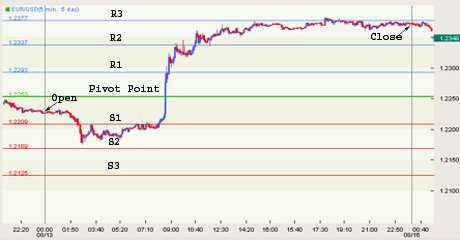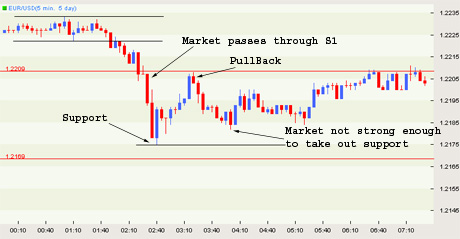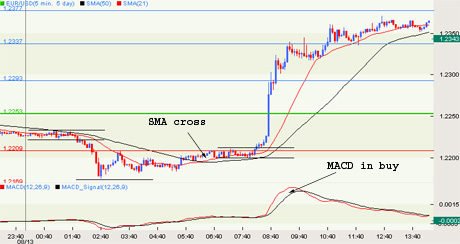Thanks,
But I could not find a chart to accommodate this calculator, which chart is availabe for free and can place the Pivot Point up?
Really want to learn and practise it with daily trading. Thanks in advance..
It is very interesting and very helpful for forumers who want to learn TA.
Appreciate a lot! Many thanks to brothers for providing useful links.
yes,
Pivot Point = ( High + Close + Low )/3
ROI25per ( Date: 21-Jul-2009 10:51) Posted:
|
http://www.surefire-forex-trading.com/PP.html
http://www.surefire-forex-trading.com/PP.html
Pivot Point Trading
Here's Your Lesson on Pivot Point Trading
You are going to love this lesson. Using pivot points as a trading strategy has been around for a long time and was originally used by floor traders. This was a nice simple way for floor traders to have some idea of where the market was heading during the course of the day with only a few simple calculations.
|
|
The pivot point is the level at which the market direction changes for the day. Using some simple arithmetic and the previous days high, low and close, a series of points are derived. These points can be critical support and resistance levels. The pivot level and levels
calculated from that are collectively known as pivot levels.
|
The reason pivot point trading is so popular is that pivot points are predictive as opposed to lagging. You use the information of the previous day to calculate potential turning points for the day you are about to trade (present day).
Because so many traders follow pivot points you will often find that the market reacts at these levels. This give you an opportunity to trade.
Before I go into how you calculate pivot points, I just want to point out that I have put an online calculator and a really neat desktop version that you can download for free HERE
If you would rather work the pivot points out by yourself, the formula I use is below:
Resistance 3 = High + 2*(Pivot - Low)
Resistance 2 = Pivot + (R1 - S1)
Resistance 1 = 2 * Pivot - Low
Pivot Point = ( High + Close + Low )/3
Support 1 = 2 * Pivot - High
Support 2 = Pivot - (R1 - S1)
Support 3 = Low - 2*(High - Pivot)
As you can see from the above formula, just by having the previous days high, low and close you eventually finish up with 7 points, 3 resistance levels, 3 support levels and the actual pivot point.
If the market opens above the pivot point then the bias for the day is for long trades as long as price remains above the pivot point. If the market opens below the pivot point then the bias for the day is for short trades as long as the market remains below the pivot point.
|
The three most important pivot points are R1, S1 and the actual pivot point. The general idea behind trading
pivot points is to look for a reversal or break of R1 or S1. By
the time the market reaches R2,R3 or S2,S3 the market will already
be overbought or oversold and these levels should be used for
exits rather than entries.
|
|
|
|
This all looks pretty straight forward. |
|
|
Unfortunately life is not that simple and we have to deal with each trading day the best way we can. I have picked a day at random from last week and what follows are some ideas on how you could have traded that day using pivot points.
On the 12th August 04 the Euro/Dollar (EUR/USD) had the following:
High - 1.2297
Low - 1.2213
Close - 1.2249
This gave us:
Resistance 3 = 1.2377
Resistance 2 = 1.2337
Resistance 1 = 1.2293
Pivot Point = 1.2253
Support 1 = 1.2209
Support 2 = 1.2169
Support 3 = 1.2125
Have a look at the 5 minute chart below

The green line is the pivot point. The blue lines are resistance levels R1,R2 and R3. The red lines are support levels S1,S2 and S3.
There are loads of ways to trade this day using pivot points but I shall walk you through a few of them and discuss why some are good in certain situations and why some are bad.
The Breakout Trade
At the
beginning of the day we were below the pivot point, so our bias is
for short trades. A channel formed so you would be looking for a
break out of the channel, preferably to the downside. In this type of
trade you would have your sell entry order just below the lower
channel line with a stop order just above the upper channel line and
a target of S1. The problem on this day was that, S1 was very close
to the breakout level and there was just not enough meat in the trade
(13 pips). This cab be a good entry technique for you. Just because
it was not suitable this day, does not mean it will not be suitable
the next day.

The Pullback Trade
This is one of
my favorite set ups. The market passes through S1 and then pulls
back. An entry order is placed below support, which in this case was
the most recent low before the pullback. A stop is then placed above
the pullback (the most recent high - peak) and a target set for S2.
The problem again, on this day was that the target of S2 was to
close, and the market never took out the previous support, which
tells us that the market sentiment is beginning to change.

Advanced
As I mentioned earlier,
there are lots of ways to trade with pivot points. A more advanced
method is to use the cross of two moving averages as a confirmation
of a breakout. You can even use combinations of indicators to help
you make a decision. It might be the cross of two averages and also
MACD must be in buy mode.
In the example below the market passed through S1 and then retraced to the S1 line again. It then formed a channel. At around this time we had a cross of the averages, MACD signaled buy and there was a breakout of the channel line. This gave a great signal to go long with a target of the original pivot line.
Mess around with a few of your favorite indicators to help determine an entry around a pivot level but remember the signal is a break of a level and the indicators are just confirmation.

We haven't even got into patterns around pivot levels or failures but that is not the point of this lesson. I just want to introduce another possible way for you to trade.
Good Trading
Mark McRae